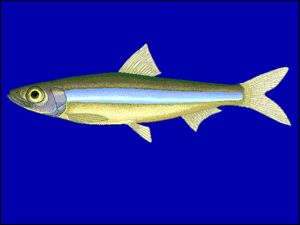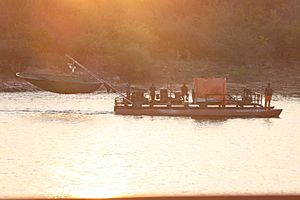Lake Tanganyika sardine facts for kids
Quick facts for kids Lake Tanganyika sardine |
|
|---|---|
 |
|
| Conservation status | |
| Scientific classification | |
| Synonyms | |
|
The Lake Tanganyika sardine (Limnothrissa miodon) is a type of small, silvery freshwater fish. It belongs to the Dorosomatidae family. Originally, these fish lived only in Lake Tanganyika in Africa. However, they have been moved to other lakes to be used as a food source. This fish is the only species in its genus called Limnothrissa. It is also known as kapenta, a name it shares with the Lake Tanganyika sprat.
Contents
Where Lake Tanganyika Sardines Live
As their name suggests, Lake Tanganyika sardines first lived only in Lake Tanganyika. They also lived in the lower parts of the Malagarasi River.
People later introduced them to other places. In 1959, they were brought to Lake Kivu in Rwanda. They were also moved to the man-made Lake Kariba in the Zambezi valley, which is between Zambia and Zimbabwe. More recently, they were introduced to the Itezhi-Tezhi Dam in Zambia. From Lake Kariba, these fish have even made their way downstream to Cahora Bassa lake in Mozambique. They managed to survive passing through the hydro-electric turbines in the Kariba Dam!
What Lake Tanganyika Sardines Look Like
This fish is a typical clupeid, which means it's a small, silvery fish. It has a bright stripe along its side. Its snout is wide and tapers (gets narrower) at the sides.
Lake Tanganyika sardines have a fairly large swim bladder. This special organ helps them move up and down easily in the water. The longest they can grow is about 17 centimeters (about 6.7 inches). However, most of them are around 10 centimeters (about 4 inches) long. They are usually ready to have babies when they are about 6.8 centimeters (about 2.7 inches) long.
Life and Habits of Lake Tanganyika Sardines
Lake Tanganyika sardines move up and down in the water every day. During the day, they stay in tight groups in deep water. At dawn (sunrise) and dusk (sunset), they rise closer to the surface. For the rest of the night, they spread out widely in the open waters. In Lake Kivu, they move to the surface in the early morning and late afternoon.
Scientists think these movements follow their food source, which is tiny creatures called zooplankton. However, this isn't always true in Lake Kariba. It seems the fish and the plankton react to the same things, so they end up in the same places at the same times. One idea is that this might be a way to avoid predators, similar to how ocean fish behave.
The depth where these sardines live depends on the water temperature layers (called the thermocline) and how much oxygen is in the water. Below the thermocline, the water often has no oxygen. From November to April, the fish are found no deeper than 20 meters (about 65 feet).
As the fish grow bigger, adults move into deeper water. Smaller, younger fish prefer clear water about 1.5 meters (about 5 feet) deep with rocky or sandy bottoms. They also live near steep shores.
Reproduction
Adult Lake Tanganyika sardines move into shallow waters to breed. This usually happens during the rainy season. Breeding peaks in May and June, and again in December and January. However, they can breed throughout the year.
The number of eggs a fish lays increases as it grows. For example, a fish from Lake Kariba that was 46 millimeters (about 1.8 inches) long had 600 eggs. Another one that was 11.4 centimeters (about 4.5 inches) long had 14,044 eggs! Fish in Lake Tanganyika lay even more eggs. A 140-millimeter (about 5.5 inches) fish there had 55,000 eggs. The main breeding time in Lake Kariba is from September to February. The number of fish usually grows from February to August, then drops due to many fish dying and fewer new fish joining the population.
What Lake Tanganyika Sardines Eat
Lake Tanganyika sardines are omnivores, meaning they eat both plants and animals. They mainly feed on zooplankton (tiny animals) and phytoplankton (tiny plants). In Lake Kariba, studies show they eat whatever food is most common at the time. Their main prey has included Bosmina longirostris, Mesocyclops spp, and Ceriodaphnia dubia.
It's possible that Lake Tanganyika sardines caused a decrease in some larger zooplankton species, like Diaptomus, Ceriodaphnia, and Diaphanosoma. These were more common in Lake Kariba before 1971. However, since no stomach contents were checked back then, we can't be completely sure what caused their decline.
In Lake Tanganyika, they have been seen eating atyid shrimps, copepods, and prawns. Larger sardines have also been known to eat the young (larva) of the Lake Tanganyika sprat. Other foods include insects like chironomids, ephemeroptera, trichoptera, and hemiptera. In some samples from Lake Kariba, these insects made up 55% of what was in their stomachs. This suggests they catch these insects at the surface at night.
How Lake Tanganyika Sardines Evolved
Most clupeid fish live in the ocean. However, Lake Tanganyika was formed by the Earth's crust pulling apart (rifting) and has never been connected to the sea. The group of fish that Lake Tanganyika sardines and their relatives belong to, called the Pellonulinae, are common in southern and western Africa. Examples include Microthrissa royauxi and Potamothrissa acuitirostris in the Congo Basin.
Scientists have studied their family tree. This research shows that the ancestors of these freshwater Pellonulines moved into West Africa about 25–50 million years ago. This happened after a large part of the ocean covered that region. These fish then developed into many new species in West Africa. They spread across the continent and moved into Lake Tanganyika when it was first forming. This means that even though Lake Tanganyika has never been directly connected to the sea, its unique freshwater clupeid fish came from ancestors that spread out from an ancient ocean area.
Meaning of the Scientific Name
The scientific name of the Lake Tanganyika sardine is Limnothrissa miodon.
- The first part, limno, comes from the Greek word for "lake." This refers to where this fish lives in Lake Tanganyika.
- The second part, thrissa, is a Greek word for a type of anchovy. It's often used as a standard ending for names of clupeid fish.
- The species name, miodon, is made of two parts: mio- means "less" or "small," and odon means "tooth." This name refers to the fact that this fish has smaller teeth compared to similar species like Pellonula vorax.
Who Eats Lake Tanganyika Sardines
In Lake Kariba, the most important predator (animal that hunts and eats others) of the Lake Tanganyika sardine is the tigerfish, Hydrocynus vittatus. The number of tigerfish in Lake Kariba grew after the sardines were introduced. The tigerfish's diet changed, and by 1971, as much as 70% of their food was sardines. Tigerfish seem to hunt sardines most actively at dawn and dusk, when they are seen feeding on them near the surface.
Other fish that eat sardines in Lake Kariba include Coptodon rendalli, Synodontis zambezensis, and Schilbe intermedius. Some birds also eat sardines in Lake Kariba and possibly other places. These include the white-winged black tern (Chlidonias leucoptera) and the pied kingfisher (Ceryle rudis).
Fishing for Lake Tanganyika Sardines
In 1967 and 1968, the Zambian government introduced 360,000 Lake Tanganyika sardines into Lake Kariba for fishing. Here, they are caught when they are about 40 millimeters (about 1.6 inches) long, which is when they are 3–4 months old. Most of the fish caught are 40–50 millimeters (about 1.6–2 inches) long and about 5 months old.
It seems that the amount of fish available is related to how much fishing is done. In 1985, the total amount of fish (biomass) was 10% lower than in 1974, when fishing began. Today, the annual catch on Lake Kariba is between 20,000 and 30,000 short tons (about 18,000 to 27,000 metric tons).
See also




